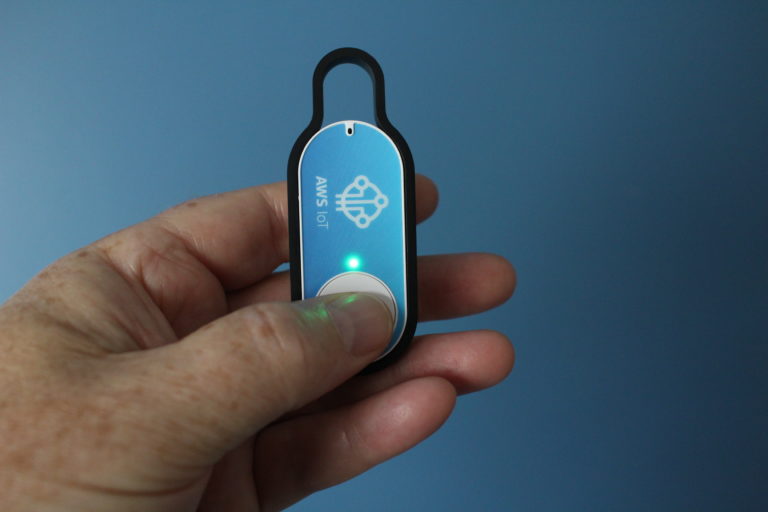In-depth Amazon coverage from the tech giant’s hometown, including e-commerce, AWS, Amazon Prime, Alexa, logistics, devices, and more.
Success! A green LED indicates that pushing the AWS IoT button communicated through Wi-Fi with the AWS Lambda service. Onscreen is the result: an email from my IoT button.
Success! A green LED indicates that pushing the AWS IoT button communicated via Wi-Fi with the Amazon Web Services Lambda service, sending an email with the heartwarming subject line, “Hello from your IoT Button [serial number]: SINGLE” and telling me the button’s battery voltage is 1650 millivolts.
tide-button
An Amazon Dash button.
You’ve probably seen those colorful Amazon “dash buttons” that will automatically reorder food, paper towels, detergent and even condoms with the push of a button. Available for Prime members only, they work with a simple smartphone app over your home Wi-Fi network — like one-click ordering but wireless and single-purpose. They’re free after you make your first order. And they’re kinda cool.
But as geeks, we’ve been more intrigued with a new Amazon button marked simply “AWS IoT.” That stands for Amazon Web Services Internet of Things, and that means pushing the button could theoretically control anything connected to the internet. Now that’s really cool. The concept is amazing, and IoT is widely thought to be The Next Big Thing in computing.
Amazon introduced its $20 IoT button in May, but there aren’t many real-world examples of it being used so far, so we decided to join the ranks of the IoT pioneers and give it a try.
Unboxing the AWS IoT button, bursting with anticipation
Unboxing the AWS IoT button, bursting with anticipation
The first thing we discovered is that, out of the box, it does precisely . . . nothing.
You can’t just push the button and have it instantly do useful things, like opening your garage door and starting your car remotely or ordering a pizza. No, it was immediately clear that it would take some effort to make the button perform even the simplest IoT task. This would not be an undertaking for the impatient or faint of heart. And to be fair, Amazon makes it clear the button is meant for use by developers, so they can learn how the AWS IoT services work.
But hey! We’re techies. We’re geeks. Granted, I have never used AWS and haven’t programmed since I taught myself C (poorly, incompletely and 25 years ago). But I can understand code samples and write Excel macros. How hard could it be? Anyway, three different Amazon customers who had bought the AWS IoT button had been kind enough to write long, detailed accounts of how to make it useful.
I had some grand — and as it turned out, grandiose — ideas. As I imagined it, a single push of the button would activate a pressure sensor on the door to the single stall in our men’s room, telling me whether it was in use. A double-press would automatically dial nearby Fremont Coffee Co. on my iPhone so I could pre-order my favorite drink. And a sustained press would send an email to everyone on the GeekWire staff to evacuate the building immediately.
Each of those is theoretically possible. Theoretically.
In I plunged, working on the project in the odd moments when nothing was more pressing.
Day One (3 hours): Our administrator set me up with an AWS account and password. I decided to ignore the written accounts of how to proceed and just follow my instincts. That was the first of many mistakes.
Moving dead slowly, I watched an “interactive tutorial” that told me about something called a device gateway, which links controlled things with controlling things, and something else called a rules engine, which sets up if-then controls. So I created a “thing” — and then quickly foundered. A screen asked for the thing’s “condition,” not explaining what that meant. True, there was an adjacent pop-up window that said “Read the documentation,” but it provided no link.
Within the first hour’s effort, I found myself asked to do many tasks I didn’t understand. It was unclear what I needed to do, in what order, and why. For example, there was a lot of instruction about something called a policy. But what was it, and why was it called that, and why did it seem to do the same things I’d already told other things to do?

Um, I have to write SQL? I know what it is and what it does (it queries relational databases), but I sure as hell don’t know how to write it.
And let’s not even talk about security! Here’s one of several security-related screens I had to contend with. It was hard not to laugh out loud at how absurdly complicated (and yet completely unexplained) the whole thing was.
Failing at everything else, I tried to “create a new resource” so I could “push a message to an SNS topic” (whatever that is). The resource was going to be the SNS target (whatever that is). But when I tried, here’s the message I received:
“User: arn:aws:iam::[number]:user/drichman is not aut
